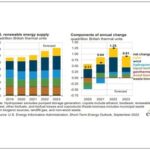EIA revises 2021, 2022 bioenergy forecasts
Energy Disrupter
ADVERTISEMENT
The U.S. Energy Information Administration currently predicts renewables will account for 20 percent of U.S. electricity generation this year, according to the agency’s latest Short Term Energy Outlook, released Aug. 10. Renewables accounted for 20 percent of U.S. electricity generation in 2020 and are expected to account for 23 percent of U.S. electricity generation in 2022.
The electric power sector is expected to generate 33.8 billion kilowatt hours (kWh) of electricity from biomass this year, including 17.4 billion kWh from waste biomass and 16.4 billion kWh from wood biomass. The sector generated 27.5 billion kWh from biomass last year, including 16.1 billion kWh from waste biomass and 11.4 billion kWh from wood biomass. Biomass generation is expected to fall to 30 billion kWh next year, including 16.1 billion kWh from wood biomass and 14 billion kWh from wood biomass.
Across other sectors, biomass generation was at 28.6 billion kWh last year, including 2.7 billion kWh from waste biomass and 25.8 billion kWh from wood biomass. Biomass generation is expected to fall to 27.9 billion kWh this year, including 2.7 billion kWh from waste biomass and 25.2 billion kWh from wood biomass. Those levels of generation are expected to be maintained through 2022.
The electric power sector is expected to consume 0.258 quadrillion (quad) of waste biomass this year, up from 0.238 quad in 2020. The sector’s consumption of waste biomass is expected to return to 0.238 quad in 2022. The electric power sector is also expected to consume 0.267 quad of wood biomass this year, up from 0.185 quad last year. Consumption is expected o fall to 0.228 quad in 2022.
The industrial sector is expected to consume 0.158 quad of waste biomass in both 2021 and 2022, up from 0.156 quad in 2020. The sector is also expected to consume 1.402 quad of wood biomass this year and 1.413 quad next year, up from 1.376 quad in 2020.
The commercial sector is expected to consume 0.035 quad of wood biomass in 2021 and 2022, up down from 0.036 quad in 2020. The sector is also expected to consume 0.082 quad of wood biomass this year and next year, down from 0.083 quad in 2020.
The residential sector consumed 0.458 quad of wood biomass in 2020. Consumption is expected to fall to 0.456 quad this year and be maintained at that level through 2022.
Across all sectors, the consumption of waste biomass is expected to be at 0.452 quad this year, up from 0.43 quad in 2020, with consumption falling to 0.431 quad in 2022. Wood biomass consumption was at 2.101 quad in 2020, and is expected to reach 2.207 quad this year before falling to 2.178 quad in 2022.
The electric power sector had 6,548 megawatts (MW) of biomass generating capacity in place as the end of 2020, including 3,850 MW of waste biomass capacity and 2,697 MW of wood biomass capacity. Biomass capacity is expected to fall to 6,438 MW by the end of this year, including 3,884 MW of waste biomass capacity and 2,554 MW of wood biomass capacity. Biomass capacity is expected to partially rebound next year, reaching 6,443 MW, including 3,889 MW of waste biomass capacity and 2,554 MW of wood biomass capacity.
Across other sectors, biomass capacity was at 6,393 MW at the end of 2020, including 789 MW of waste biomass capacity and 5,603 MW of wood biomass capacity. Biomass capacity is expected to fall to 6,359 MW by the end of 2021, including 790 MW of waste biomass capacity and 5,569 MW of wood biomass capacity. Biomass capacity is expected to fall to 6,351 MW next year, with waste biomass capacity being maintained at 790 MW and wood biomass capacity falling to 5,561 MW.
















